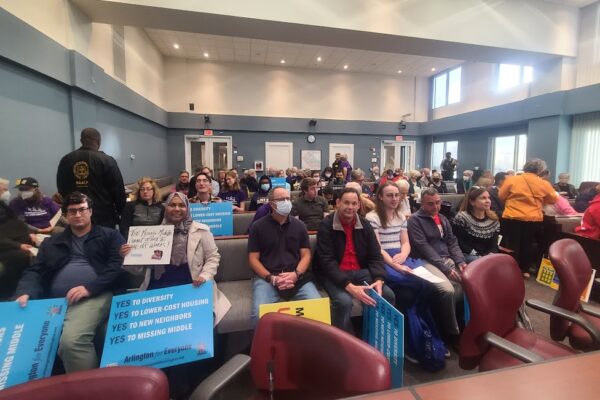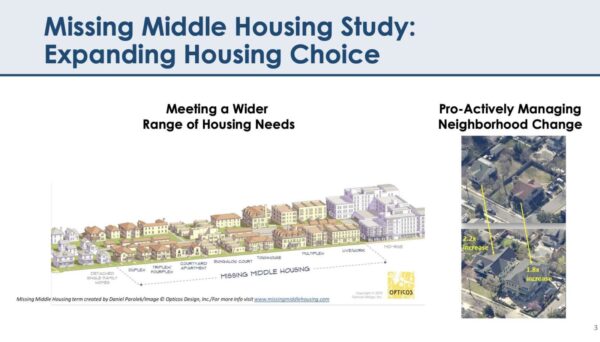
Arlington Planning Commission is set to discuss Missing Middle housing in a blockbuster pair of meetings this week.
The first is happening tonight at 7 p.m., in the County Board room at Arlington County government headquarters (2100 Clarendon Blvd). County staff are set to give a presentation before the floor is opened to public comment from dozens of speakers.
Then, on Thursday, a second meeting is planned for members of the Planning Commission to discuss the current Missing Middle housing proposal, which has sparked a fierce community debate.
Planning Commission members are set to provide guidance, including on the scope of the Missing Middle proposal, to the County Board for its vote on advertising public hearings on the topic. That will precede additional Planning Commision and County Board votes on the final Missing Middle proposal, which are currently likely to happen at some point in early 2023.

Ahead of the meetings tonight and Thursday, of which we will have coverage the next day, we asked the GPT-3 artificial intelligence writing model to weigh in on the pros and cons of the Missing Middle issue, below, in what might be somewhat of a preview of the public comment.
Admittedly, the AI did not discuss trees, which have been a hot topic among many Missing Middle opponents.
Write an essay describing the pros and cons of re-zoning residential neighborhoods of Arlington, Virginia to permit lower density multifamily housing, such as townhouses and duplexes, also known as Missing Middle housing.
The debate over re-zoning residential neighborhoods of Arlington, Virginia to permit lower density multifamily housing, also known as Missing Middle housing, is a controversial one that has been debated for many years. On one side, there are those who argue that re-zoning residential neighborhoods to allow for the construction of Missing Middle housing represents a positive step in creating a more diverse and affordable housing market. On the other hand, there are those who oppose the idea, arguing that it will bring about changes to their neighborhood that they do not want or need. To understand the potential pros and cons of re-zoning residential neighborhoods of Arlington, Virginia to permit lower density multifamily housing, it is important to look at both sides of the argument.
The primary argument in favor of re-zoning residential neighborhoods of Arlington to allow for the construction of Missing Middle housing is that it could provide much-needed affordable housing in an area that is increasingly becoming unaffordable. In addition, it could create more diverse neighborhoods by allowing for a greater variety of housing types and styles. Furthermore, it could increase the local tax base and provide economic benefits to the area by creating more jobs and businesses. Finally, it could also help reduce traffic congestion by providing people with more options for living closer to where they work and play.
On the other hand, there are valid arguments against re-zoning residential neighborhoods of Arlington to permit Missing Middle housing. One of the primary concerns is that it could lead to an increase in traffic and congestion in the area, as well as an increase in noise and other nuisances. Additionally, some fear that it could lead to an increase in crime or an influx of renters who have little or no interest in being good neighbors. In addition, it could lead to an increase in property values, which could make it difficult for those who already own homes in the area to afford to remain there. Finally, there is also concern that it would lead to a decrease in the quality of life of existing residents, who may feel that their neighborhood is being changed in ways they do not want or need.
Ultimately, whether or not re-zoning residential neighborhoods of Arlington to permit Missing Middle housing is a good idea depends on the individual situation and the desires of residents. While there are potential pros and cons associated with this type of zoning change, it is important for local authorities to carefully consider all perspectives before making any decision.
In another preview of tonight’s rhetorical battle, the Washington Post weighed in on Missing Middle over the weekend, examining how the terminology used helps to shape the debate.
From the Post:
Duston, a retired real estate agent who owns a five-bedroom Cape Cod in Alcova Heights, said she talks with her neighbors about Arlington “ending single-family zoning” because it more clearly communicates how the county’s plan might affect older houses in the neighborhood.
“It hits people where they live,” she said. “They can easily visualize the house next door being torn down and a multiunit building going up [and the increase in] cars or people associated with it.”
[…]
Schuetz, the Brookings economist, said this kind of rhetoric demonstrates how the phrase can be used to provoke a more upsetting — and false — notion: that banning single-family zoning means your own single-family house will be banned, too.
“Whether you’re offering a vision of something positive for society or criticizing something that exists does matter in the tone,” she said. “The ‘invading a single-family neighborhood’ language that gets used all the time can also feel aggressive and hostile to people.”

